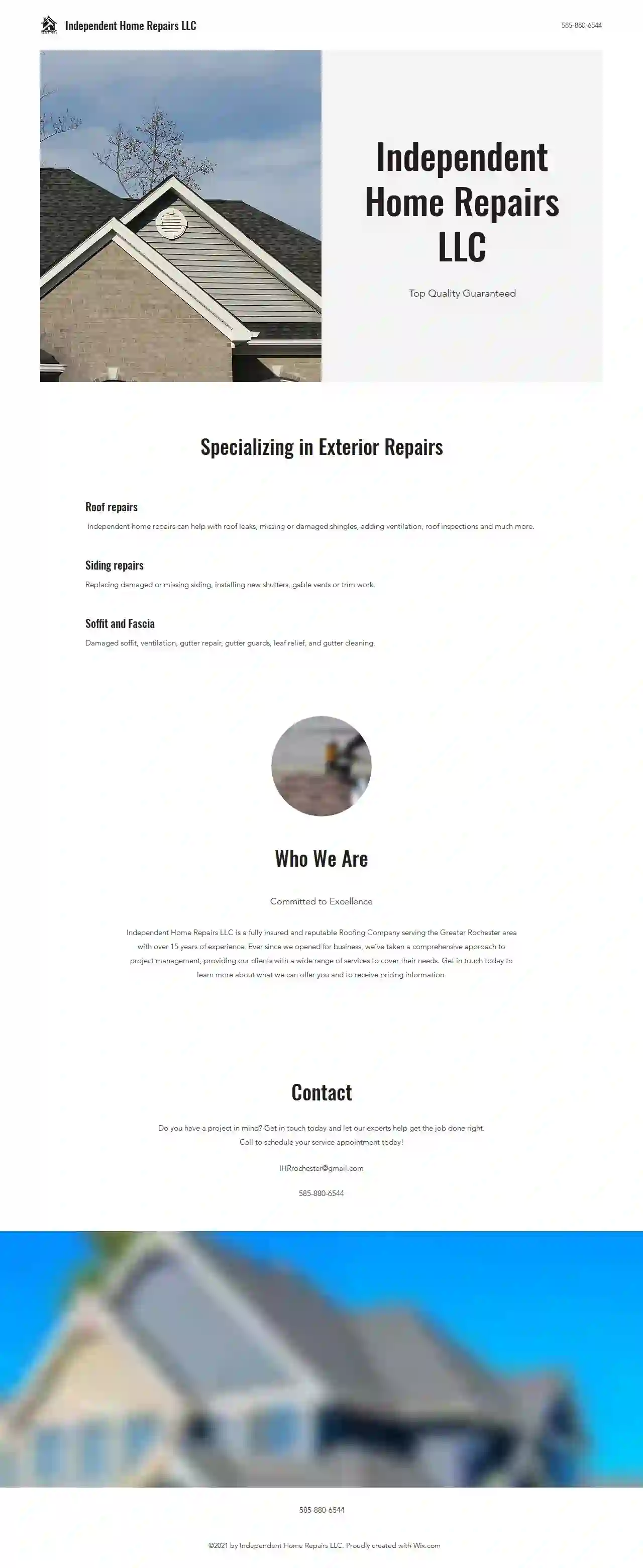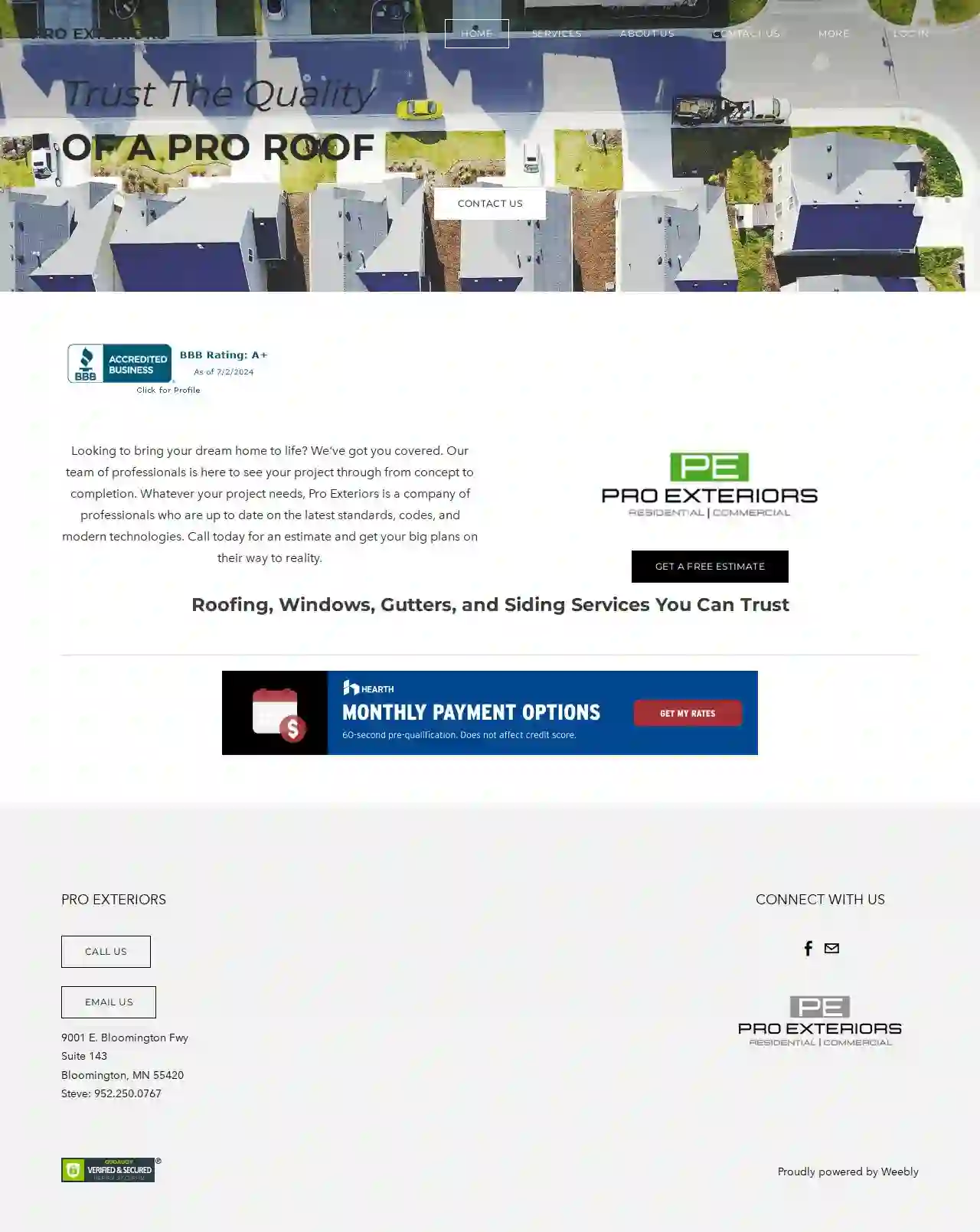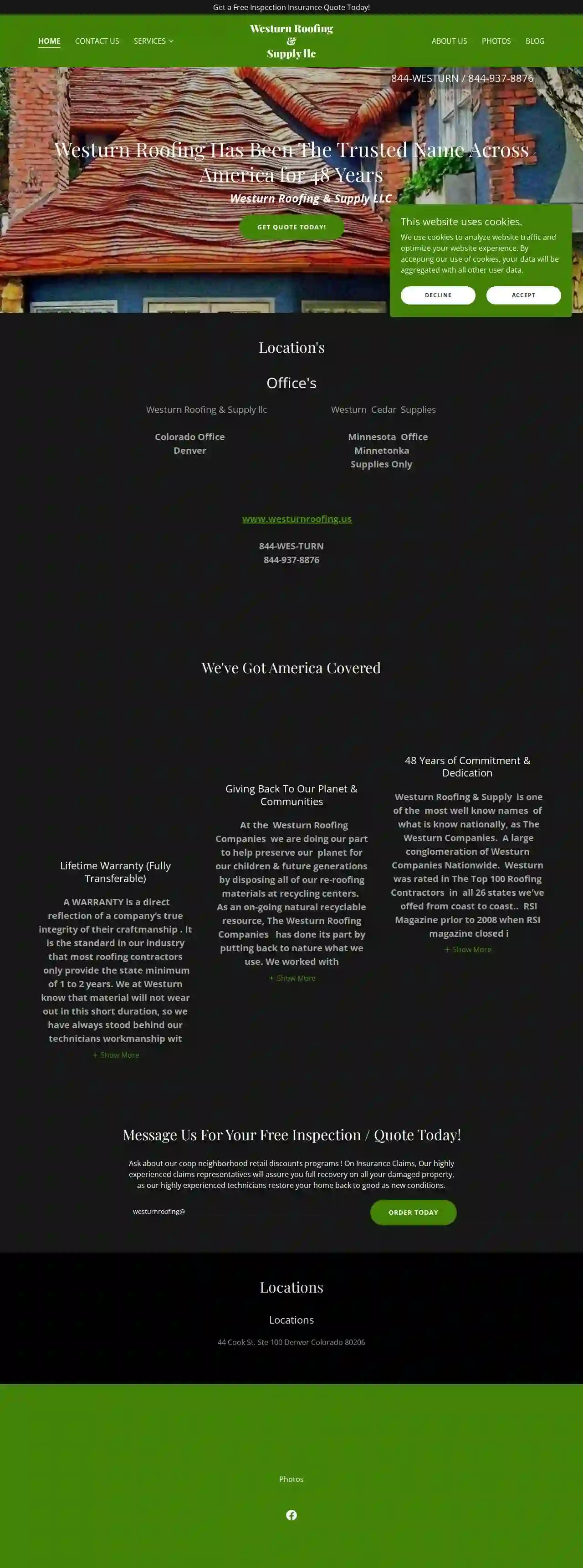Roofing Companies Otsego
Best Roofing Company in Otsego
Get up to 3 Roofing Services quotes for your project today! Compare profiles, reviews, accreditations, portfolio, etc... and choose the best offer.

Weathersafe Restoration, Inc.
4.7126 reviewsSuite 200B, 1103 Weir Dr., Woodbury, 55125, USConveniently located in Woodbury, MN, Shakopee, MN, and Hudson, WI, Weathersafe Restoration provides exceptional quality in roofing repair, siding and window replacement, and storm damage repair services at the lowest possible prices. NOW HIRING!We are looking to hire a self-motivated, energetic individual that is looking for an opportunity to change their life.Inquire Now!At Weathersafe Restoration, we’re a business devoted to positive interactions, reliability, and timely services.Our sole priority is to ensure that every customer witnesses our commitment to consistently exceeding expectations. Our mission of keeping your home, or your business, safe and healthy is a responsibility we never take lightly—especially in the face of weather-related dangers.About Weathersafe RestorationServing Minneapolis, St. Paul, the MN Metro areas, and Hudson, WI, we strive to maintain the maximum level of professionalism, integrity, and fairness in our relationships with insurance companies, suppliers, professional associates, subcontractors, and all our customers!Residential RoofingSiding Installation & RepairGutter InstallationResidential Window ReplacementCommercial RoofingOutstanding ReputationSince 1994, Weathersafe Restoration, Inc., continues to build on its outstanding reputation in the Twin Cities and St. Croix Valley area.
- Services
- Why Us?
- Accreditations
- Testimonials
- Gallery
Get Quote
Fit The Bill Construction
526 reviews9531 Foley Blvd, Coon Rapids, 55433, USPremier Roofing and Exteriors Company in the Twin Cities Area. Fill The Bill Main Office is located at 9531 Foley Blvd, Coon Rapids, MN 55433. We have a second location at 3208 Oakland Ave, Minneapolis, Mn 55407. Our team is dedicated to providing exceptional service and quality workmanship. We have a proven track record of delivering outstanding results, as evident from our numerous testimonials from satisfied clients.
- Services
- Why Us?
- Testimonials
- Gallery
Get Quote
Keyprime Roofing & Remodeling
4.9146 reviewsSuite 760, 1000 Boone Avenue N, Golden Valley, 55427, USAt Keyprime Roofing and Remodeling, we have established a reputation as a premier roofing contractor in Minneapolis, Minnesota. Our business success is built on the personalized attention and care we bring to every job we do. We are dedicated to creating a positive and inspiring experience for each of our customers. We combine superior work with top-notch building materials and personalized service. Asphalt shingles, cedar shakes, and metal roofs—we carry them all for your home. Learn more about us and our commitment to excellence.
- Services
- Why Us?
- Accreditations
- Our Team
- Testimonials
- Gallery
Get Quote
MNSOTA CONSTRUCTION
528 reviews1700 Livingston Ave Suite 200, West St Paul, 55118, USMNSOTA CONSTRUCTION is a top tier exteriors company providing Twin Cities homeowners and businesses with friendly, professional, and high quality exterior solutions. Our mission is to provide homeowners with peace of mind, knowing they have a reliable partner at their side to help them through the exterior restoration process. Raising the standard, one project at a time. Our Company is built on a strong foundation of family values. We value Honesty, Integrity, and Service above all else. MNSOTA CONSTRUCTION was established to serve as a beacon of trust and reliability for homeowners in the Twin Cities. Our mission is to navigate the complex terrain of exterior restoration with ease, offering our clients not just services but the ultimate peace of mind. We built MNSOTA CONSTRUCTION on the belief that every homeowner deserves a partner who is both honest and dependable through every step of the process.
- Services
- Why Us?
- Our Team
- Testimonials
- Gallery
Get Quote
Independent home repairs
52 reviewsRochester, USIndependent Home Repairs LLC is a fully insured and reputable Roofing Company serving the Greater Rochester area with over 15 years of experience. We've taken a comprehensive approach to project management, providing our clients with a wide range of services to cover their needs.
- Services
- Why Us?
- Gallery
Get Quote
The Good Roofer
56 reviews123 Main St, Rochester, 14609, USWelcome to The Good Roofer, your trusted partner for all your roofing needs in the Rochester, New York. With years of experience in the industry, we are committed to providing exceptional roofing services that exceed your expectations. At The Good Roofer, we take pride in our skilled team of professionals who are dedicated to delivering top-quality craftsmanship and outstanding customer service. Whether you need roof repairs, installations, or maintenance, we have the expertise and knowledge to handle any roofing project efficiently and effectively. Trust us to protect your property with durable and reliable roofing solutions.
- Services
- Why Us?
- Accreditations
- Our Team
- Gallery
Get Quote
Pro Exteriors LLC
530 reviewsSuite 143, 9001 E. Bloomington Fwy, Bloomington, 55420, USComplete Home Contractors Serving Minnesota Since 2014. Every one of our professional installers has many years of experience in the field. You will know you are getting the "Best in the Business" when you hire Pro Exteriors for your siding, roofing, or window and gutter replacement. Our number one priority is customer satisfaction from start to finish with every job. We set high standards for our workmanship and take pride in our results. We desire to provide a quick and high quality solution to all of our customers' needs. It is deeply satisfying to extinguish any issues the customer may have or challenges that come along any given project. We hope that through our trustworthy and quality installations we become your "go-to" exterior management company.
- Services
- Why Us?
- Accreditations
- Our Team
- Testimonials
- Gallery
Get Quote
Sellers Roofing Company - New Brighton
4.839 reviews366 New Brighton Road, New Brighton, 55112, USAt Sellers Roofing Company- New Brighton, we provide top-quality roofing services tailored to meet the unique needs of homeowners in the Minneapolis and Saint Paul area. Our team of experienced professionals specializes in roof installations, repairs, and storm damage restoration. We are committed to delivering exceptional craftsmanship, superior customer service, and reliable results. Servicing New Brighton, Minneapolis, Saint Paul, Mounds View, Shoreview, Roseville With over 14 years of experience serving both residential and commercial clients in Minneapolis and Saint Paul we’ve earned a reputation as a dependable and trusted choice. Our commitment to competitive pricing combined with expert craftsmanship distinguishes us in the industry. At Sellers Roofing Company- New Brighton, we offer a diverse range of services tailored to meet both residential and commercial roofing needs. From new roof installations and repairs to addressing storm damage, our seasoned team consistently delivers exceptional results. But our expertise isn’t limited to roofing. We also provide remodeling and home improvement services designed to enhance both the functionality and aesthetics of your property. What truly sets us apart is our steadfast commitment to customer satisfaction. We place paramount importance on building and maintaining trust with every homeowner and business owner we engage with. By treating your property as if it were our own, we ensure meticulous attention to detail and use only the highest-quality materials. Choose Sellers Roofing Company- New Brighton for dependable service, unmatched craftsmanship, and unparalleled customer care. Reach out to us today to discuss your roofing and remodeling needs and discover the difference we can bring to your home or business.
- Services
- Why Us?
- Accreditations
- Gallery
Get Quote
Westurn Roofing & Siding
11 reviews44 Cook St. Ste 100, Denver, 80206, USWesturn Roofing & Supply LLC has been a trusted name across America for 48 years. We've installed over 243,000 roofs and are committed to providing the best quality and service to our customers. Our mission is to become the choice of the community by offering top-notch craftsmanship and exceptional customer service. We've built a reputation for excellence, and our customers know they can rely on us for a problem-free roof for the life of their roofing system. Westurn now offers a FULLY 100% LIFETIME CRAFTSMANSHIP WARRANTY on all our roofs, giving you peace of mind knowing your investment is protected. Call us today for a free inspection and estimate, and let our highly experienced representatives explain how this is possible!
- Services
- Why Us?
- Gallery
Get Quote
NMC Exteriors
4.8513 reviewsPlymouth, MN, 14505 21st Ave N, 55447, USNMC Exteriors – In Partnership with Apple Roofing Your Trusted Exterior Renovations Partner Since 1999, NMC Exteriors has led the way in high-quality exterior renovations throughout the Greater Twin Cities. We’re extremely proud of our reputation for top-notch service, but we know that our 20+ years of success is due to one reason, and one reason alone: we always put our customers first!From siding and roofing to windows and gutters, we recognize that our clients are our best asset, and we’re committed to doing whatever it takes to wow them. Building on our commitment to excellence, we are thrilled to announce our new partnership with Apple Roofing. This strategic alliance not only strengthens our position in the industry but also allows us to offer even more innovative and comprehensive solutions to our valued customers. Together with Apple Roofing, we look forward to continuing our tradition of excellence and delivering unparalleled service in every exterior renovation project.
- Services
- Why Us?
- Accreditations
- Our Team
- Testimonials
- Gallery
Get Quote
Over 17,196+ Roofing Contractors onboarded
Our roofing pros operate in Otsego and surroundings!
Roofyng.com has curated and vetted the Best Roofers in and around Otsego. Find the most reliable contractor today.
Frequently Asked Questions About Roofing Companies
- Home Improvement Loans: Offered by banks or credit unions.
- Home Equity Loans or Lines of Credit: Use your home's equity as collateral.
- Government Programs: Check for energy efficiency rebates or grants.
- Contractor Financing: Some roofing companies offer financing plans.
- Safety First: Avoid going onto the roof during a storm, as it's dangerous.
- Document the Damage: Take photos and videos of the damage for insurance purposes.
- Contact Your Insurance Company: Report the damage to your insurance company as soon as possible to initiate a claim.
- Temporary Repairs: If safe, address any immediate leaks using buckets or tarps to minimize further damage.
- Contact a Roofing Contractor: After the storm, have a qualified roofing contractor inspect the roof and provide a repair estimate.
- Hot Climates: Opt for light-colored or reflective roofing materials to reduce heat absorption. Consider tile roofs for their thermal mass and heat resistance.
- Cold Climates: Ensure your roof has adequate insulation and ventilation to prevent ice dams and moisture buildup. Metal roofs can shed snow effectively.
- High-Wind Areas: Choose roofing systems with high wind ratings and properly installed hurricane straps or clips to enhance wind resistance.
- Areas with Heavy Rainfall: Ensure your roof has proper drainage and a waterproof membrane to prevent leaks.
How can I get financing for a new roof?
What should I do with my old roof after replacement?
What should I do if my roof is damaged in a storm?
How do I choose the right type of roof for my climate?
How can I get financing for a new roof?
- Home Improvement Loans: Offered by banks or credit unions.
- Home Equity Loans or Lines of Credit: Use your home's equity as collateral.
- Government Programs: Check for energy efficiency rebates or grants.
- Contractor Financing: Some roofing companies offer financing plans.
What should I do with my old roof after replacement?
What should I do if my roof is damaged in a storm?
- Safety First: Avoid going onto the roof during a storm, as it's dangerous.
- Document the Damage: Take photos and videos of the damage for insurance purposes.
- Contact Your Insurance Company: Report the damage to your insurance company as soon as possible to initiate a claim.
- Temporary Repairs: If safe, address any immediate leaks using buckets or tarps to minimize further damage.
- Contact a Roofing Contractor: After the storm, have a qualified roofing contractor inspect the roof and provide a repair estimate.
How do I choose the right type of roof for my climate?
- Hot Climates: Opt for light-colored or reflective roofing materials to reduce heat absorption. Consider tile roofs for their thermal mass and heat resistance.
- Cold Climates: Ensure your roof has adequate insulation and ventilation to prevent ice dams and moisture buildup. Metal roofs can shed snow effectively.
- High-Wind Areas: Choose roofing systems with high wind ratings and properly installed hurricane straps or clips to enhance wind resistance.
- Areas with Heavy Rainfall: Ensure your roof has proper drainage and a waterproof membrane to prevent leaks.
